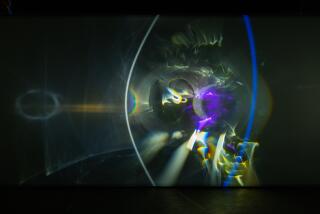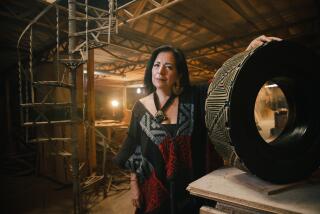On meandering journeys
- Share via
MEXICO CITY — FRANCIS ALŸS is doing something pretty extraordinary, for him. He’s sitting still, more or less.
But this relative stasis probably will be short-lived. The gangly Belgian artist already looks restless, dragging on a cigarette, his 6-foot-4 frame scrunched into the corner of a packed cafe surrounded by a quintessential Mexico City scene: barking dogs, a TV futbol match blaring in the background, an old man playing harmonica for spare change, a dozen conversations bouncing off the walls -- the relentless, seductive chaos of contemporary urban life.
It’s the kind of purposeful disorder that Alys relishes, a situation rife with the sort of unpredictable, dramatic possibilities that he’s constantly itching to see unfold -- and to goose along, when necessary. This is an artist, after all, who gets his kicks by running into killer tornadoes with a rolling video camera. Who stalked the elusive nandu, a South American ostrich, across Patagonia like some big-game hunter bagging exotic metaphors. Who wandered around Copenhagen for a week stoned each day on a different drug. And who once loped through the streets of this hair-trigger metropolis dangling a loaded 9-millimeter Beretta from one hand, just “waiting for something to happen,” as he put it.
It did too: Several members of the Mexican constabulary, understandably mistaking Alys for a homicidal lunatic, threw him in the back of their squad car and took him away. The next day Alys went back and explained to the cops that he was an artist, then asked them to restage the incident exactly as it had occurred, while a collaborator filmed the reenactment with a Sony HandyCam. Using reality as a dry run, an aesthetic calisthenic, Alys fashioned a startling dual-screen urban parable in which physical peril, like verisimilitude, lies in the eye of the beholder.
“The first bit was pretty tense,” Alys recalls in his gentle French-accented English. The police officers “still were pretty upset about the whole scenario. And then at one point the word ‘art’ came in, and then it was fine, because art wasn’t serious. You know, you couldn’t mean it to be dangerous if it was an artistic kind of manifestation.”
Of course, there’s a double-barreled irony in the cops’ perception that art is harmlessly absurd, a perception that gets scrutinized in “Francis Alys: Politics of Rehearsal,” which runs through Feb. 10 at the Hammer Museum. Curated by Russell Ferguson, professor and chairman of the UCLA department of art, “Politics of Rehearsal” examines how Alys takes a calculatedly off-the-cuff approach to art-making, seizing on momentary opportunities and embracing haphazardness.
“He’s very interested in things that are ephemeral or impromptu or improvised,” says Ferguson, who in his catalog essay compares Alys’ approach to that of an actor preparing for a role that is always, essentially, a work in progress. Alys regards this seemingly ad-lib approach to art-making as “a better solution,” Ferguson says, than some overarching system that tries to bend everything in its path to a fixed set of principles or objectives. “He loves to create a kind of situation or a mini-narrative or a set of events and then set that loose and let it reverberate around him.”
Between intent and result
In spite of, or rather precisely because of this methodology, Alys’ conceptual interventions and their video byproducts give memorable, if transient, form to the scattershot nature of contemporary existence, particularly as it plays out in sharp-elbowed hyper-cities like this one, the artist’s home for most of the last two decades.
He arrived in the Mexican capital at an auspicious moment for artists. It was the mid-1980s, shortly after the city had been leveled by a magnitude-8.0 earthquake that left at least 10,000 people dead. In Mexico City’s devastation, Alys, an aspiring architect at the time, witnessed first-hand the literal destruction of what he calls “blind Modernism,” the secular faith of the 20th century Western world.
Practically on the spot, he dropped architecture and decided to become an artist. Apart from a brief European sojourn in the early 1990s, Alys has remained here ever since.
Not only Mexico, but other parts of Latin America such as Peru and Patagonia have become his creative milieu, and his work often alludes to the region’s incessantly cyclical problems: the gaping economic disparities, the entrenched political corruption, the glacial pace of reform and the grinding repetitiveness of daily life among the working poor.
This idea of an entire hemisphere afflicted by a collective sensation of deja-vu-all-over-again, condemned to keep repeating its historical traumas and setbacks, informs the stop-and-go tempo of much of Alys’ art. The Mexican art critic and curator Cuauhtemoc Medina, who has collaborated with Alys, has observed that the artist’s political interventions expose and comment on Latin America’s “general problem of the entropy of daily economic life, that is, the unimaginable effort we all make in getting nowhere.”
Few of his projects have expressed this idea with more succinctly humorous eloquence than “Paradox of Praxis 1” (1997), in which Alys spent more than nine hours pushing a large, rectangular block of ice through the streets of Mexico City’s historic center, a complex public space whose grimy baroque grandeur encapsulates all the contradictions of Mexican society. By nightfall, the monumental glacial mass had been reduced to a dinky frozen chip, kicked along by the artist in his trademark Converse high-tops.
Odysseus or Sisyphus? A mytho-poetic journey of discovery, or a ludicrous, anti-heroic exercise in futility? Much of Alys’ art questions what, in the end, is the difference between the two, while simultaneously smudging the boundary between artistic intent and result.
It would be a mistake, however, to get the impression that Alys simply lets his art sneak up on him or his viewers.
Once he develops a rough concept for a project, he typically storyboards the idea on paper, as if he were scripting a movie. He gathers props and materials together, orchestrates the action up to a point and documents the effects with photos and video.
Then, at some crucial, unforeseen moment, the gesture acquires its own momentum and takes on its own life. Usually, no one is more surprised at what happens next than the artist himself.
“As much as I’m clear why I’m doing something, when I’m stepping out I very quickly lose understanding of why I was doing it,” Alys says. “Whereas while I’m in it, it’s crystal clear. And that’s probably what helps the . . . ‘improvisation’ is not the right word. But on the base of a very simple plot, sometimes a quite complex and sometimes a quite long action can start developing without any strict rules, but there is a clear pattern which I’m following, although it is pretty much built up every other day.”
He compares his artistic method to a swimmer watching the riverbank steadily recede from him. “The more I’m developing the narrative, the further I am from what I’m trying to say.”
Yet many of those who have observed or participated in his narrative-building projects, or both, have found that Alys’ work speaks with a deceptively simple, blank-verse elegance that translates into many languages and across many cultures.
One of his most publicized and representative projects took place five years ago in Peru, as part of the Lima Biennale. He, Medina and a small team of collaborators recruited 500 volunteers armed with shovels to the outskirts of a desert shantytown, where they attempted by collective spade-work to shift the top of a sand dune by 4 inches. The resulting performance piece/political intervention, “When Faith Moves Mountains” -- which shared certain affinities with the Earth Art of the 1970s but implicitly subverted its grandiose ambitions -- functioned as a subtle symbol of how ordinary Peruvians, their country rived by years of guerrilla-backed civil war and brutal government reprisals, could unite around a common purpose, however ultimately inconsequential.
“I think what I’m trying to do is twist the plot, slightly, so that people can look at the situation from a different perspective,” Alys says.
“The little you can do as an artist,” he continues, is to “offer for a few minutes or a few seconds the possibility of another reading or observation.
“It’s kind of bizarre, but you can physically feel the shift, if you want, around you, the way somebody just creates a moment of doubt.”
In that moment, he believes, lies the potential for gaining some small understanding of a place, a culture or an idea that once might have seemed utterly alien and impenetrable. Alys’ style is to arrive at that moment not by taking the shortest distance between two points, but through indirection, paradox and purposeful meandering.
In “The Green Line Walk” (2004), Alys ambled through Jerusalem carrying a dribbling can of green paint, roughly retracing the boundary that Israeli commander Moshe Dayan drew on a map with a green grease pencil when he partitioned the city after the November 1948 Arab-Israeli war. “The reason I went there, it wasn’t clear to me,” Alys says characteristically, “but probably because I found it such an archetypal situation of human conflict over thousands of years.”
‘A fable or an urban myth’
Given the politically charged, physically risky character of some of his projects, Alys occasionally can seem to be less involved in a “politics of rehearsal” than in playing Russian roulette with a loaded allegory. But as Ferguson notes, Alys’ approach is as much poetic as political. His interventions are “not agitprop in the traditional sense,” Ferguson says, “they’re just things that get into your mind the way a poem may get into your mind, and you can turn it over a number of different ways.”
Accordingly, his absurdist beaux gestes aren’t insider-ish, Dadaist quips but relatively straightforward jokes that most everyone can get -- for instance, the time that he sent a peacock to represent him at the Venice Biennale. (The creature obligingly strutted around showing off its fine plumage to the assembled glitterati.)
Alys says that his narratives aspire to pass from the temporal realm of action into stories spread by word of mouth, however vaguely recounted, that can outlive their “artistic” genesis. He has put it this way: “If the script meets the expectations and addresses the anxieties of that society at that time and place, it may become a story that survives the event itself. At that moment, it has the potential to become a fable or an urban myth.”
There’s another key to many of Alys’ projects, whether they involve traipsing past Israeli military checkpoints or charging into the middle of a natural disaster. “You learn to walk fast,” he says. A man in motion stays in motion, and Alys is eager to head back to work at his studio, a 40-minute walk away, in the city’s historic center.
But before he leaves, he agrees to stand still long enough to have his picture taken. As it turns out, the photographer is on her way to cover a hurricane that’s blowing into Mexico from the Caribbean. Alys smiles and pleads, only half-jokingly, “Can I come?”
Isn’t running into cyclones kind of dangerous? he is asked. Alys considers this.
“You wait 10 hours for two tornadoes to pass,” he says, as if tedium were a greater threat to mortal flesh than 100-mph winds.
“Sometimes it’s very tense,” he concedes. “But then, it just suddenly clicks.”
--
‘Francis Alys: Politics of Rehearsal’
Where: UCLA Hammer Museum, 10899 Wilshire Blvd., Westwood
Ends: Feb. 10
Price: $3-$5
Contact: (310) 443-7000, www.hammer.ucla.edu
More to Read
The biggest entertainment stories
Get our big stories about Hollywood, film, television, music, arts, culture and more right in your inbox as soon as they publish.
You may occasionally receive promotional content from the Los Angeles Times.











